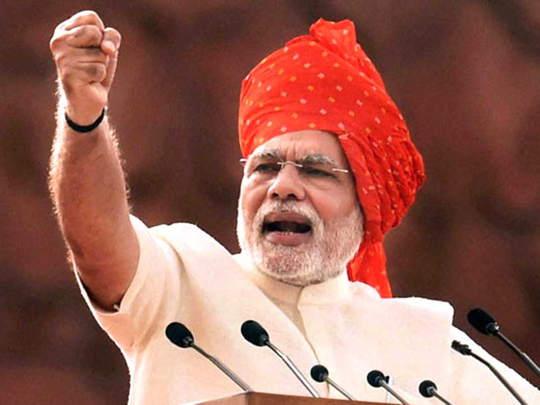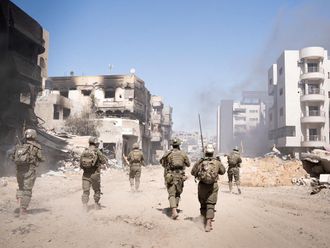
Ravi India celebrates its 72nd Independence Day today. And Prime Minister Narendra Modi, the most followed Indian on social media, unsurprisingly used his twitter handle to ask for ideas for his Independence Day speech. He also happens to be the best dressed prime minister the country has had. And speculation is rife on the head gear he will choose to wear for the event especially after Congress party’s Shashi Tharoor’s comments set off a firestorm. The Independence Day speech is a report card.
A listing of the achievements of the government of the day and a peep into the future, a state of the union overlaid with promises, the tone and tenor stirring, with a mishmash of history. The ramparts of the Red Fort inspires soaring oratory. This will be Modi’s fifth and last speech before the general elections of 2019 and is likely to be his most important public performance as he prepares for the general elections. A rousing speech, is expected, high on rhetoric and promises to bring about transformative change: A feisty and combative act, even theatrical, full of exhortations as well as deflections More on ‘deflection’ later.
Independence Day is a time for reflection and one should imbue a spirit of give and take and forge a common purpose in nation building. Commentary needs to shun partisanship and drain the one-sided reportage of daily news. For whether one likes Modi or not, the nation has marched forward, and it was done under his watch. India is rated as the world’s fastest-growing large economy, with a brisk projected increase in GDP of 7.8 per cent.
Recently, India replaced its numerous federal and state taxes with the Goods and Services Tax (GST), designed to unify the country into a single market. “No country of comparable size and complexity has attempted a tax reform of this scale,” said the BBC. Yes, much has gone wrong in its implementation, but who can deny that it was a stupendous achievement.
And ‘Cooperative Federalism’ has at last come to mean something, indeed even redefine ‘Unity in diversity’ the nation’s founding principle. India’s image abroad has also undergone a makeover since 2014. Modi has projected a vibrancy and self- confidence that has not been seen for a very long time.
Modi and provincialism
One may disagree with Modi’s style, holding massive public rallies that resemble rock concerts, conducting yoga classes for a worldwide audience but even his strongest detractors will concede that he has transformed and altered radically the office of the prime minister. It is presidential in style and substance, and while all power emanates from him, he is a agent of change and willing to take risks.
And as he frequently strides up the red carpeted gangplank of Air India One, to attend a flurry of international summits, he has attained a status of a world leader; and this in turn burnishes India’s image. He is a powerful public speaker and besides being seen at world capitals he is also constantly seen at the hustings, campaigning for local elections, decimating the opposition and cleverly deflecting criticism. Unfortunately he does himself a disservice, when he starts speaking like a provincial leader; pushing narrow partisan interests. Sadly this happens too often.
Under him, the cabinet style of governance has broken down, and he is the sole decision maker; not primus inter pares but numero uno. As the country inches towards the 2019 elections, it will be a referendum of Modi’s rule of five years and for all practical purposes a presidential type election; Modi versus the rest. And the coming polls will be a watershed; will it be more of Modi and his total ascendancy over national matters or will we see him fall from grace, both outcomes have serious implications.
In India, it would appear the Bharatiya Janata Party (BJP) under Modi has finessed a Soviet-style propaganda tool to bludgeon criticism on a variety of issues. Whether it be press censorship or violence and lynchings or corruption, the party spokesperson’s default stance is to immediately cite a series of happenings under the Congress rule.
Starting from the 1976 declaration of emergency, the Delhi killings of 1984, to big scale corruption that was typified by the Bofors scandals of 1980s. This is nothing but moral relativism, a form of false moral equivalence. Philosopher Merold Westphal said that only people who know themselves to be guilty of something “can find comfort in finding others to be just as bad or worse.”
Surely this cannot be the legacy that our hard working prime minister-an epithet used very often to disparage him — wants to leave behind. As he faces his sternest test ever — unlike 2014 when there was no incumbency — the challenges this time around are monumental; he has to defend his rule of five years, and deflection may not work.
The law of diminishing returns is catching up but he is standing on the cusp of history. A second 5-year term will seal his place as one of the most consequential prime ministers of India. Every year on the Independence Day he has announced a new idea, from ‘Start Up India’ to ‘Make in India’. This time when he is up on the ramparts of the Red Fort he needs to go beyond platitudes if he wants go down in history not as the most consequential but as the greatest prime minister of India.
Ravi Menon is a Dubai-based writer, working on a series of essays on India and on a public service initiative called India Talks.










